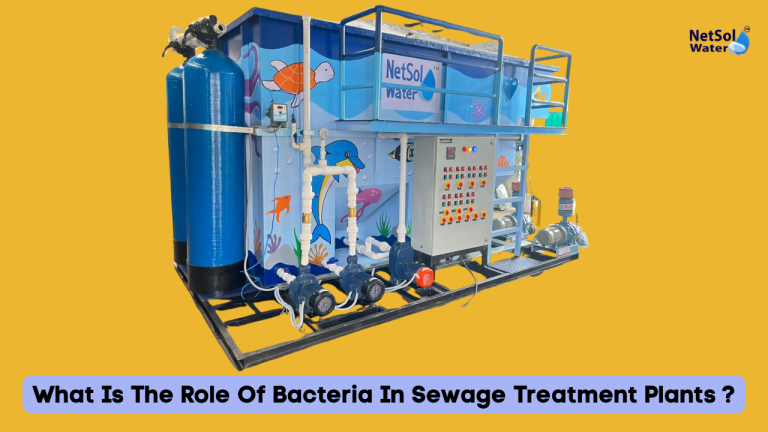
In sewage treatment units & facilities, bacteria compel the purification process in a fast mode. Wastewater is regularly cleaned by these microscopic organisms that break down organic pollutants. Without bacteria, sewage treatment would be difficult. Let’s look at how these tiny assistants restore the cleanliness of our water denoting the role of bacteria in sewage treatment plants of Commercial RO Plant.
The fundamentals of treating wastewater
Wastewater full of sewage waste is acquired from many point sources by sewage treatment facilities. A variety of contaminants are present in this effluent. To enable safe release of clean water, treatment aims to remove these contaminants.
Typically, the process consists of several steps:
- Large debris is removed by preliminary treatment.
- Solid stuff is settled out by first primary treatment.
- Microorganisms including certain bacteria are specially incorporated in secondary treatment to provide biological cleansing of raw water.
- Better purification is achieved with tertiary treatment.
- Disinfection eliminates any leftover bacteria.
Although they assist throughout the process, bacteria put in their most effort during secondary therapy.
Types of Bacteria with Crucial Role employed in Sewage Treatment Plants
Various bacteria flourish in systems made at Commercial RO Plant that treat sewage & wastewater. Researchers have divided bacteria into two major groups: anaerobic as well as aerobic bacteria.
For aerobic microorganisms to thrive, oxygen is very much needed. When there is an abundance of oxygen, they breakdown substances that are organic. Aeration tanks are where you’ll come across them most active.
Anaerobic bacteria do not require oxygen to play their role. They breakdown organic waste in limited oxygen supply such as sludge-digesters in specific conditions of the environments.
The following bacterial species are frequently found in treatment plants at Commercial RO Plant:
- E. coli
- Nitrosomonas
- Bacillus
- Nitrobacter
- Pseudomonas
Every variety of bacteria has diverse unique roles to be played in Sewage Treatment Plants. For instance, ammonia is converted to nitrates by Nitrosomonas as well as Nitrobacter.
The role that microbes play in primary or the initial treatment
Even with basic treatment, bacteria begin to function. Bacteria start decomposing organic compounds in wastewater when it settles in settling tanks. The workload for later phases is reduced by this first step.
Bacterial activity during the course of treatment
Bacteria’s true potential is shown during secondary treatment. This technique is motivated by the activated sludging process. This is how it operates:
- Wastewater mixed with live bacteria is sent to aeration tanks.
- Pumped air provides aerobic bacteria with oxygen.
- Bacteria consume organic materials & then break them down into smaller compounds.
- A sludge deposit rich in bacteria is created when bacteria produce bigger particles called “flocs” while they operate.
- Some bacteria absorb components like nitrogen as well as phosphorus.
Operators of STP plants must maintain a perfect environment for progressive bacterial growth. To maintain bacterial growth, they keep an eye on temperature, pH, along with oxygen levels.
Anaerobic digestion & bacterial activity
Anaerobic microbes handle the treatment of sludge. Complex organics are broken down without oxygen in anaerobic digesters. Biogas is considered the most economical green energy source which is even renewable form of energy, is formed by the application of this method.
Anaerobic digestion necessitates several steps:
- Complex molecules are broken down by hydrolysis,
- Volatile fatty acids are produced by acidogenesis,
- Hydrogen, plus carbon dioxide along with hydrocarbon groups of acetic acid are generally produced by acetogenesis.
- Carbon dioxide as well as methane are produced by means of methanogenesis process.
This method produces important biogas while reducing the volume of sludge.
Ecosystems & populations of bacteria in sewage treatment
Advanced bacterial communities are found in sewage plants. Together, these communities filter wastewater. These communities are shaped by environmental conditions, wastewater composition, plus plant design.
Maximizing treatment requires an understanding of these ecosystems. Bacterial ecosystems’, their variety & function are revealed by novel techniques like metagenomics. This knowledge leads to more effective treatment methods.
Conclusion
Role of Bacteria in sewage treatment plants powers the purification & cleaning process. Our wastewater with sewage waste is continuously purified by these tiny microorganisms i.e., Bacteria. From initial primary treatment to the ultimate extraction of clean water, they operate at every stage. Using bacterial power improves the way sewage is treated. Microorganisms are becoming growing more important as worries about water management increase. A healthier environment & cleaner water are encouraged by ongoing advancements in bacterial processes specially discovered by expert researchers at Commercial RO Plant.
Remember how your tap water was cleansed by billions of microorganisms? It emphasizes the power of nature & human ingenuity in addressing a basic problem: waste management & water supply protection.
